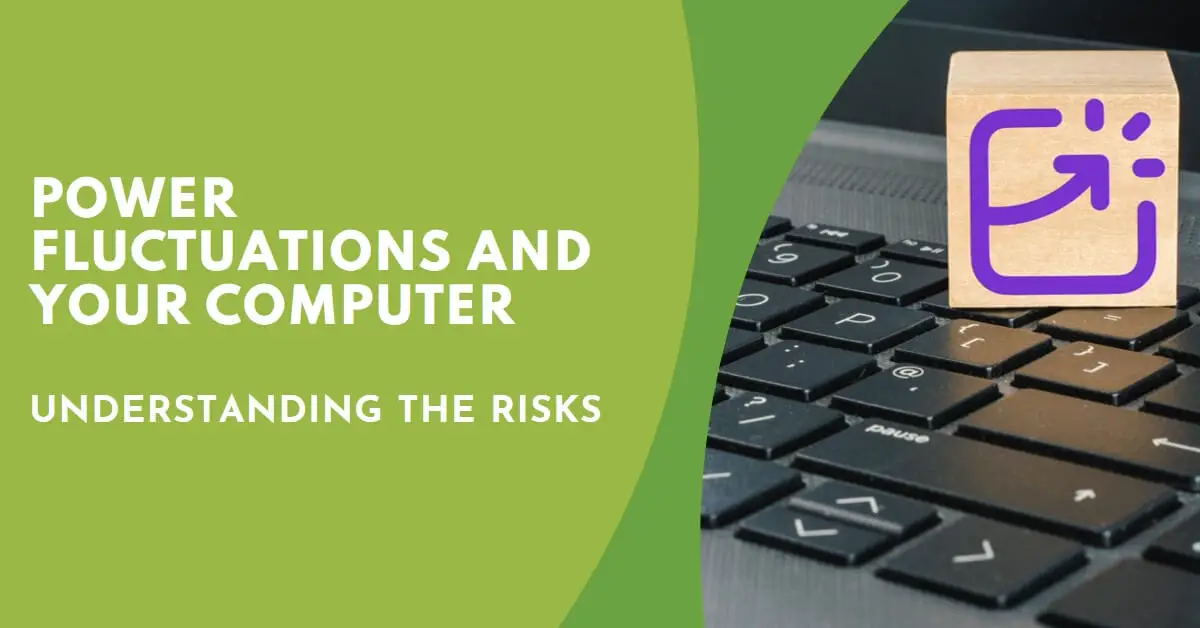Image: “Article Feature Image” by Bing is licensed under [CC BY-NC-SA 4.0]. Source: Bing Graphic Art.
Power fluctuations can pose a significant risk to your computer’s health and performance. These fluctuations, characterized by irregular changes in voltage levels, can be caused by various factors such as lightning strikes, electrical grid issues, or faulty wiring.
Understanding the potential harm they can inflict on your computer is crucial for protecting your investment and ensuring its longevity. Power fluctuations can harm your computer.
Understanding Power Fluctuations
Power fluctuations refer to the fluctuating voltage levels in an electrical supply. They can occur due to several reasons, including storms, power grid instability, or problems within your home’s electrical system.
These fluctuations can take different forms, such as overvoltage (increased voltage), undervoltage (decreased voltage), power surges (short-term voltage spikes), and power sags (short-term voltage drops).
Each type of fluctuation carries its own set of risks and can impact your computer in various ways.
Potential Harm to Computers
Effect of Power Fluctuations on Hardware
Overvoltage can cause excessive heat and damage sensitive electronic components. It may lead to burnt circuits, melted wires, or even complete system failure.
On the other hand, undervoltage can result in insufficient power supply to components, leading to malfunctions, slow performance, and potential data loss.
Power surges and sags can cause sudden voltage spikes or drops, overwhelming or underpowering the computer, respectively, and causing similar issues as overvoltage and undervoltage.
Impact on Computer Components
Power fluctuations can adversely affect various computer components:
- The Central Processing Unit (CPU), responsible for executing instructions, can suffer performance degradation or complete failure due to power irregularities.
- Random Access Memory (RAM), used for temporary data storage, may experience data corruption or become unreliable during power fluctuations.
- Hard Disk Drives (HDD) and Solid State Drives (SSD), responsible for long-term data storage, are susceptible to damage, data loss, or file corruption.
- Graphics Processing Units (GPU), used for rendering images and videos, can be affected by power fluctuations, leading to visual artifacts or system instability.
- The motherboard, acting as the central hub connecting all components, is vulnerable to power-related issues, impacting overall system functionality.
- Other peripheral devices such as monitors, printers, or external hard drives can also be harmed, rendering them inoperable.
Read also my article: Don’t Let Voltage Fluctuations Destroy Your Laptop.
Risks and Consequences
The consequences of power fluctuations on your computer can be significant:
- Data Loss and Corruption: Power fluctuations can cause data loss or corruption, jeopardizing important files, documents, or personal data.
- System Instability and Crashes: Fluctuations in power supply can lead to frequent crashes, freezing, or unexpected system shutdowns, disrupting your work or gaming sessions.
- Reduced Lifespan of Components: Continuous exposure to power fluctuations can shorten the lifespan of computer components, requiring more frequent repairs or replacements.
- Increased Repair and Replacement Costs: Dealing with power-related damage can be expensive, with repair costs piling up if multiple components are affected.
- Potential Fire Hazards: In extreme cases, power fluctuations can generate excessive heat, potentially leading to electrical fires and posing a safety risk.
Protecting Your Computer from Power Fluctuations
To safeguard your computer from power fluctuations, consider the following measures:
- Uninterruptible Power Supply (UPS): Invest in a UPS system to provide backup power during outages and regulate voltage levels to prevent damage from fluctuations.
- Surge Protectors: Use surge protectors to shield your computer from sudden voltage spikes caused by power surges.
- Voltage Regulators: Employ voltage regulators to stabilize voltage levels and protect your computer from fluctuations.
- Proper Electrical Wiring: Ensure that your home or office has proper electrical wiring to minimize the risk of power irregularities. Consult a professional electrician if needed.
- Regular Maintenance and Updates: Keep your computer’s software and firmware up to date. Regularly clean dust from internal components and ensure proper airflow to prevent overheating issues.
Conclusion
Power fluctuations can indeed harm your computer, potentially causing hardware damage, data loss, system instability, and increased repair costs.
Understanding the risks involved and taking proactive measures to protect your computer from power irregularities is essential.
Investing in equipment like UPS systems, surge protectors, and voltage regulators, along with maintaining proper electrical wiring, can significantly reduce the chances of power-related damage.
By taking these precautions, you can ensure the longevity and optimal performance of your computer, providing you with a reliable and secure computing experience.
you work With Electricity! Don’t leave empty-handed!
Looking to stay ahead of the game in the world of electrical engineering? Subscribe to my YouTube channel and gain access to exclusive content you won’t find anywhere else!
The staff I recommend (Amazon Affiliate Links to products I believe are high quality):
- Economy 120 Volt/60Hz AC Power Source – Step-Down Voltage & Frequency Converters 1800W
- UNI-T Digital Multimeter Tester UT139C
- 50-Amp Extension Cord for RV “100ft”
- Voltage Stabilizer 110/220v
- Hair Dryer “best selling“
- TOSHIBA EM131A5C-BS Countertop Microwave Ovens
Disclaimer: This contains affiliate links to Amazon products. I may earn a commission for purchases made through these links.



